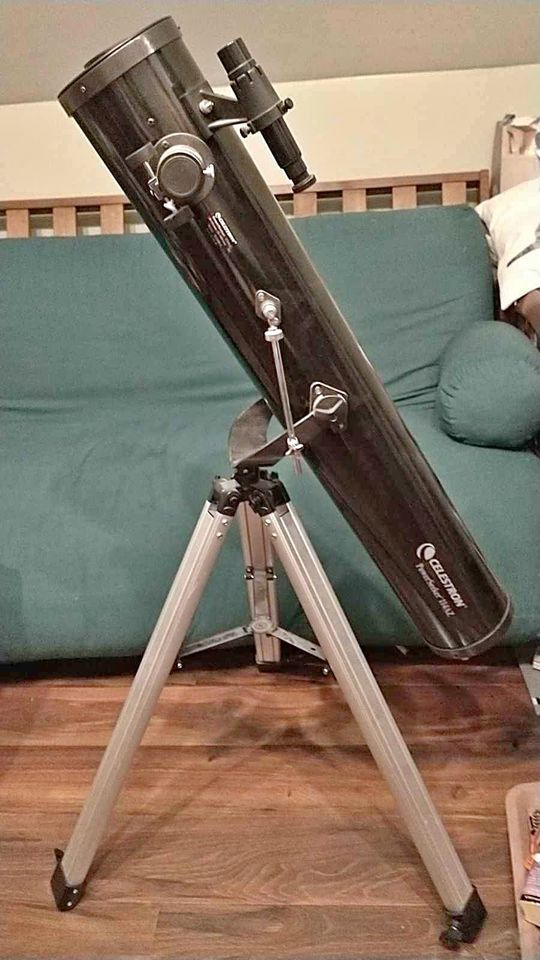The PowerSeeker 114 Optical Tube
The Celestron PowerSeeker 114 optical tube (both EQ and AZ versions) is a 114mm (4.5”) f/8 Newtonian reflector, identical to the Orion XT4.5.

These scopes actually provide very sharp views when coupled with quality eyepieces. Unlike with even the best fast tabletop Dobsonians, collimation is super easy and coma is a non-issue with a 4.5” f/8. The focuser on the PowerSeeker 114 is a 1.25” rack-and-pinion which works satisfactorily, and both the primary and secondary mirrors on the PowerSeeker 114 are collimatable. If put on a Dobsonian mount and supplied with quality eyepieces (which would basically make it into a poor man’s Orion XT4.5), the Celestron PowerSeeker 114AZ would be an excellent scope. Unfortunately, this is not the case.
Accessories with PowerSeeker 114AZ
Like all PowerSeekers, the 114AZ comes with a 20mm “erect-image” Kellner-like eyepiece (providing 45x), a 4mm Ramsden (providing 225x, too much for the telescope), an all-plastic 3x Barlow lens, and a 5×24 finderscope with optics worse than the ones found in toy pirate spyglasses.
The 20mm erect-image eyepiece uses a prism to flip the image upright, so you can use the Celestron PowerSeeker 114AZ for terrestrial viewing without the view being upside down. However, this prism is cheaply made and, as a result, sucks up a lot of light and causes sharpness and scattering issues. The field of view is narrow, too, at less than 40 degrees, making it feel like one is looking through a soda straw. Also, 45x is rather much for a low-power eyepiece – the 36x provided by a typical 25mm eyepiece is more ideal.
The 4mm Ramsden uses two incredibly cheap and tiny lenses and an optical design dating to the 18th century. The field of view is narrow (about 30 degrees), the eyepiece adds significant chromatic aberration and flares to images, and looking through it is somewhat of a challenge due to the tiny eye lens and non-existent eye relief, forcing one to press their eyeball right up against the glass to see anything. And all of this is rather moot, as the 225x it provides is too much for a 4.5” telescope.
The 3x Barlow probably costs Celestron under a dollar to make and is entirely plastic. Using it with the 20mm eyepiece should result in 135x, but in practice, the aberrations Barlow adds make the image so fuzzy that it’s useless. And of course, the 675x it provides when used in conjunction with the 4mm Ramsden is laughably outlandish for almost any backyard telescope, let alone a small 4.5” Newtonian.
The 5×24 finderscope supplied with all PowerSeekers uses a single plastic lens element – arguably worse than the lens in Galileo’s first telescope – and an aperture stop to suppress the aberrations resulting from such a cheap lens, making the already-dim view almost unusable. Additionally, the eyepiece is equally primitive, focusing the finder is difficult, and the bracket is cheaply made, making it difficult to align the finder with the main telescope. I don’t get why this finder is supplied with cheap telescopes anymore, as a far-superior red-dot sight can be bought for as little as $15 separately and probably could be thrown in without increasing the price by more than a few dollars. You can actually buy one of the said sights and install it right in place of the 5×24 finderscope if you desire, without any drilling holes or removing screws/nuts inside the tube, but obviously this doesn’t solve the other accessory issues or the unstable, cheaply-made mount.
PowerSeeker AZ Mount
The PowerSeeker AZ mount is an extremely primitive alt-azimuth fork. Originally designed to hold 60mm-70mm department-store quality refractors, which already stretched its capacity, Celestron has elected to enlarge the forks to hold the 4.5” f/8 Newtonian optical tube. The thin, extruded-aluminum tripod legs almost entirely fail to hold the scope steady, even at 45x, and attempting to move or focus the scope results in unbearable vibrations. There are also no slow-motion controls of any kind on the mount. It’s hard to believe, but the EQ1 mount supplied with the PowerSeeker 114EQ is better than the 114AZ’s mount – at least it has slow-motion controls and holds the scope somewhat adequately at low powers.
Should I buy a Used Celestron PowerSeeker 114AZ?
Ironically, if you can get a Celestron PowerSeeker 114AZ at a low enough price used, it’s quite good value if you have any woodworking skills whatsoever. A few hours of work with plywood, pipe flanges, and a vinyl record can produce a working, stable, and easy-to-use Dobsonian mount for the 114AZ at a relatively low cost, and you can buy new eyepieces and a functional red-dot finder or Telrad to aim the telescope with.
Alternative Recommendations
Even at the relatively low price category of the PowerSeeker 114AZ, there are quite a few decent alternatives with good optics, good accessories, and stable mounts:
- The Zhumell Z100 and Orion SkyScanner 100 (which are essentially the same telescope) have quality optics, easy-to-use tabletop Dobsonian mounts, and their wide fields of view and red-dot finders make them easy to aim. Both scopes can also be mounted on sturdy photo tripods with a ¼ 20 socket.
- For a bit more money, the Zhumell Z114 offers the same aperture as the PowerSeeker 114AZ but again with a stable tabletop mount and fairly decent eyepieces.
- The SarBlue Mak60 is a very small instrument, but it’s a surprisingly entertaining and ultra-portable telescope that provides great views of the Moon and planets.
For finding more options, we recommend you check out our Telescope Ranking page and Best Telescopes guide.

